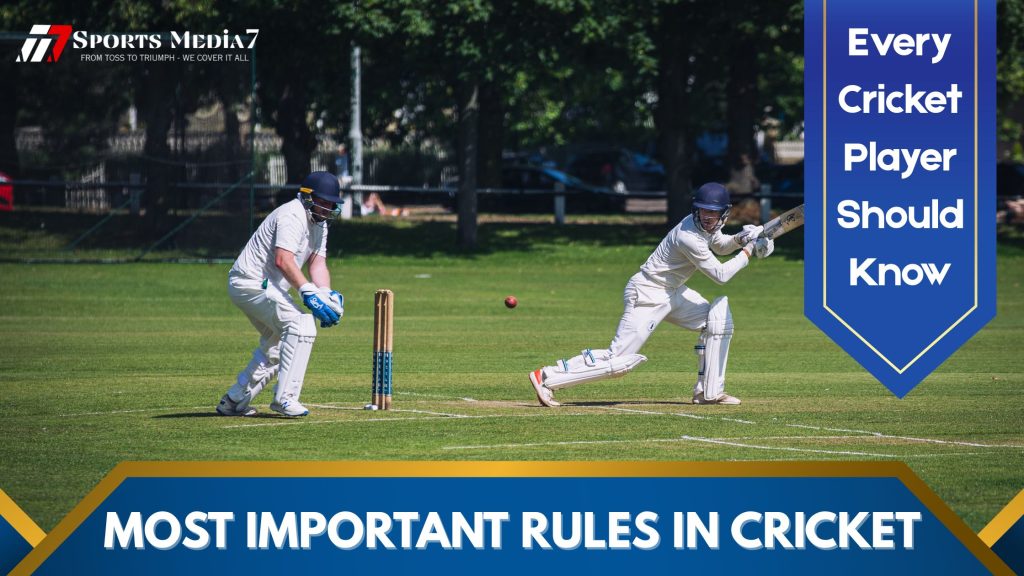
Cricket is more than just a sport — it’s a passion, a discipline, and for many, a way of life. Whether you’re an amateur, a rising talent, or simply someone who enjoys playing on weekends, knowing the basic rules and regulations of cricket is essential to perform well and enjoy the game responsibly.
we’ll walk you through the key rules every cricket player must understand — simple enough for beginners and detailed enough to help any player sharpen their cricket IQ.
⚙️ Understanding the Basics of Cricket
✅ Structure of the Game
Cricket is played between two teams of 11 players each. The game consists of innings where one team bats to score runs and the other bowls and fields to restrict them.
Depending on the format, matches can be:
- T20 (20 overs per side)
- ODI (50 overs per side)
- Test cricket (unlimited overs, usually over 5 days)
🎯 Objective of the Game
The batting team aims to score as many runs as possible, while the bowling/fielding team tries to dismiss the batters and limit the runs.
Whichever team scores the most runs wins the match.
🏃♂️ Scoring Runs in Cricket
Runs can be scored in several ways:
- By running between the wickets after hitting the ball
- By hitting the ball to the boundary (4 runs)
- By hitting the ball over the boundary without it touching the ground (6 runs)
- Through extras like wides, no-balls, byes, and leg byes
❌ Common Ways a Batsman Can Be Out
There are multiple ways to dismiss a batsman, including:
- Bowled – The ball hits the stumps
- Caught – The ball is caught by a fielder or wicketkeeper
- LBW (Leg Before Wicket) – Ball hits pads and would hit the stumps
- Run Out – Batter fails to make it to the crease before the ball hits the stumps
- Stumped – Wicketkeeper removes the bails while batter is out of the crease
- Hit Wicket – Batter hits their own stumps
- Timed Out, Obstructing the Field, Handling the Ball – Rare, but valid dismissals
🧤 Bowling and Fielding Rules
Bowling Rules:
- A legal delivery must not be a no-ball or a wide.
- A no-ball occurs if the bowler oversteps the crease or bowls above waist height.
- A wide ball is one that’s out of reach of the batter.
Fielding Restrictions:
In limited-over formats, fielding restrictions like powerplays apply:
- Only a certain number of fielders are allowed outside the 30-yard circle.
- There are also limits on how many fielders can be on the leg side.
👨⚖️ The Role of Umpires
Umpires are the on-field authorities responsible for:
- Making decisions on dismissals
- Signaling no-balls, wides, boundaries
- Keeping time and ensuring fair play
In professional matches, the Decision Review System (DRS) helps review certain decisions.
🎽 Dress Code and Equipment
Cricketers are expected to wear:
- Team uniforms (white for Tests, colored kits for T20/ODI)
- Pads, gloves, helmets, and guards for safety
- Spikes or cricket shoes for better grip
Bat, ball, and stumps must meet size and weight regulations.
🧠 Important Cricket Terminologies
- Innings: A team’s turn to bat or bowl
- Crease: The line batters must stay behind to avoid being out
- All-Rounder: A player who excels at both batting and bowling
- Free Hit: A delivery after a no-ball where the batter can’t be out except run out
🕊️ Spirit of Cricket
Beyond rules, respect is key — for teammates, opponents, umpires, and the game itself. Fair play, honesty, and teamwork define the true cricketer.
🏁 Final Thoughts
Understanding cricket rules isn’t just about avoiding mistakes — it’s about playing smarter, respecting the game, and growing as a player.
Whether you’re dreaming of IPL glory or playing in your local league, make these rules your foundation. As the saying goes, “You can’t master the game unless you know the rules.”
📢 Want more cricket content?
Follow Sports Media 7 on YouTube & Instagram for match highlights, live streams, and cricket stories from across India.
📞 Contact: 94933 95333 | Alt: 94912 95333
📧 Email: sm7india@gmail.com


